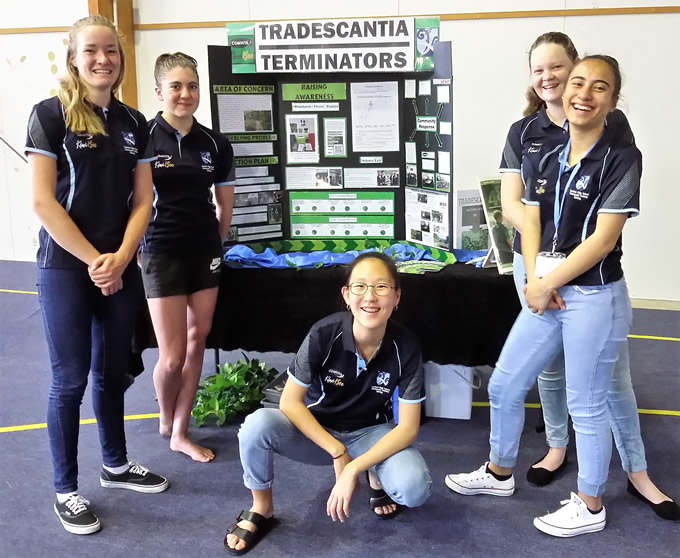Tradescantia Terminators off to Boston
A team of seven students from Kerikeri High School have been making a big impression in their Northland community and have recently been awarded first place in the Senior Community Problem Solving Division at the 2018 Future Problem Solving New Zealand National finals. The students are now preparing to attend the Future Problem Solving Program International Conference at the University of Massachusetts Amherst, USA, in June 2019.
With the guidance of science teacher Sandra Leaming and entomologist Dr Jenny Dymock, the students, dubbed “The Tradescantia Terminators”, have been working with the community on a project that includes elements of science communication and stream-side restoration or kaitiakitanga (guardianship).
Their competition display was draped with blue silk that flowed across the table. Team member Emilia Finer explained that “the silk symbolised Te Wairere waterfall and the Wairoa stream, one of the arteries of Papatūānuku in which the water, her life blood, flows”.
The students started their project in 2017 after walking down the newly opened Wairoa Stream Track. Once a popular attraction, access to the stream and spectacular Te Wairere waterfall had been lost to the community for over 60 years due to subdivision and the subsequent growth of weeds.
The project involved translocating the leaf beetle (Neolema ogloblini) and stem beetle (Lema basicostata), two biocontrol agents that have been released in the region to combat tradescantia (Tradescantia fluminensis), a weed that prevents regeneration of native vegetation. The agents, nicknamed Shiny and Knobbly, were released beside the Wairoa Stream 2 years ago and the students compared the level of plant cover before and after the beetles were released. Their results suggested that the tradescantia biomass had halved since the beetles had arrived and it was nowhere near as dense where the beetles had been busy.

The team engaged with a wide range of people, including entomologists from the Ministry for Primary Industries (MPI), council staff and community groups, including Friends of the Wairoa Stream. They also ran community workshops and set up a Facebook page to share the message about biocontrol of tradescantia.
“What impressed me,” said Jenny, “was the enthusiasm and dedication the students showed.” She described them as self-motivated and having great initiative, and said “they even set up a mock Environmental Protection Authority hearing where they debated the pros and cons of introducing a new organism into the New Zealand environment.” Another of the school’s science fair entries focusing on statistics and the abundance of wētā in areas with and without tradescantia also scored highly.
Since the promotion of the project by the students there have been numerous enquiries from people wanting to know how to collect and distribute the beetles to areas where tradescantia is a problem. “At the workshops they showed people how to make a pooter to collect the beetles and the best way to transport them to new sites,” added Jenny. “Quite often once people know where and how to look for the beetles they phone me back to say that the beetles are already present. This tells me that the beetles are naturally dispersing and reaching new sites by themselves, which is really encouraging,” Jenny said.
The success of the students follows that of Aimee Leaming, who won the Far North Science Fair in 2016 and then went on to win her category at the Taiwan International Science Fair. Aimee’s project looked at whether you could reliably tell male and female tradescantia beetles apart and whether they had different feeding strategies depending on the level of light they were exposed to.
